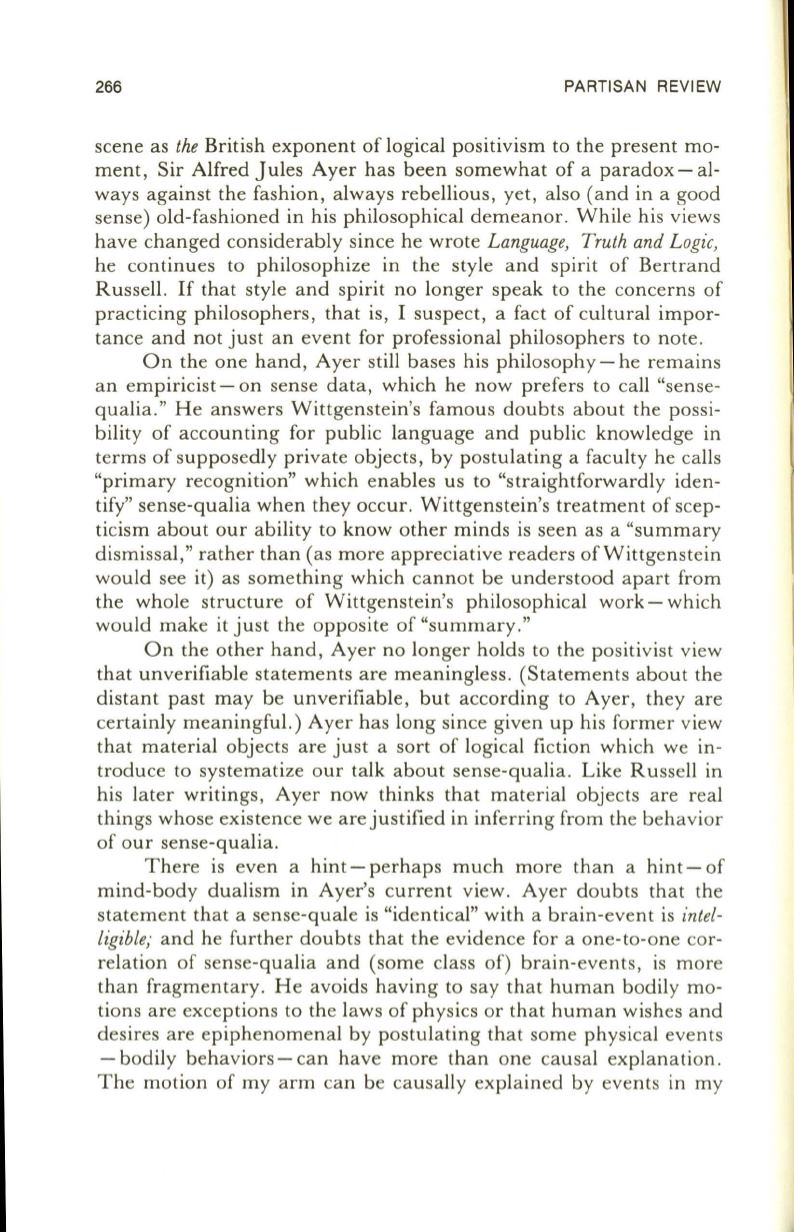
266
PARTISAN REVIEW
scene as
the
British exponent of logical positivism to the present mo–
ment, Sir Alfred Jules Ayer has been somewhat of a paradox-al–
ways against the fashion, always rebellious, yet, also (and in a good
sense) old-fashioned in his philosophical demeanor. While his views
have changed considerably since he wrote
Language, Truth and Logic,
he continues to philosophize in the style and spirit of Bertrand
Russell.
If
that style and spirit no longer speak to the concerns of
practicing philosophers, that is, I suspect, a fact of cultural impor–
tance and not just an event for professional philosophers to note.
On the one hand, Ayer still bases his philosophy - he remains
an empiricist - on sense data, which he now prefers to call "sense–
qualia." He answers Wittgenstein's famous doubts about the possi–
bility of accounting for public language and public knowledge in
terms of supposedly private objects, by postulating a faculty he calls
"primary recognition" which enables us to "straightforwardly iden–
tify" sense-qualia when they occur. Wittgenstein's treatment of scep–
ticism about our ability to know other minds is seen as a "summary
dismissal," rather than (as more appreciative readers ofWittgenstein
would see it) as something which cannot be understood apart from
the whole structure of Wittgenstein's philosophical work - which
would make it just the opposite of "summary."
On the other hand, Ayer no longer holds to the positivist view
that unverifiable statements are meaningless. (Statements about the
distant past may be unverifiable, but according to Ayer, they are
certainly meaningful.) Ayer has long since given up his former view
that material objects are just a sort of logical fiction which we in–
troduce to systematize our talk about sense-qualia. Like Russell in
his later writings, Ayer now thinks that material objects are real
things whose existence we are justified in inferring from the behavior
of our sense-qualia.
There is even a hint - perhaps much more than a hint - of
mind-body dualism in Ayer's current view. Ayer doubts that the
statement that a sense-quale is "identical" with a brain-event is
intel–
ligible;
and he further doubts that the evidence for a one-to-one cor–
relation of sense-qualia and (some class of) brain-events, is more
than fragmentary. He avoids having to say that human bodily mo–
tions are exceptions to the laws of physics or that human wishes and
desires are epiphenomenal by postulating that some physical events
- bodily behaviors- can have more than one causal explanation.
The motion of my arm can be causally explained by events in my


